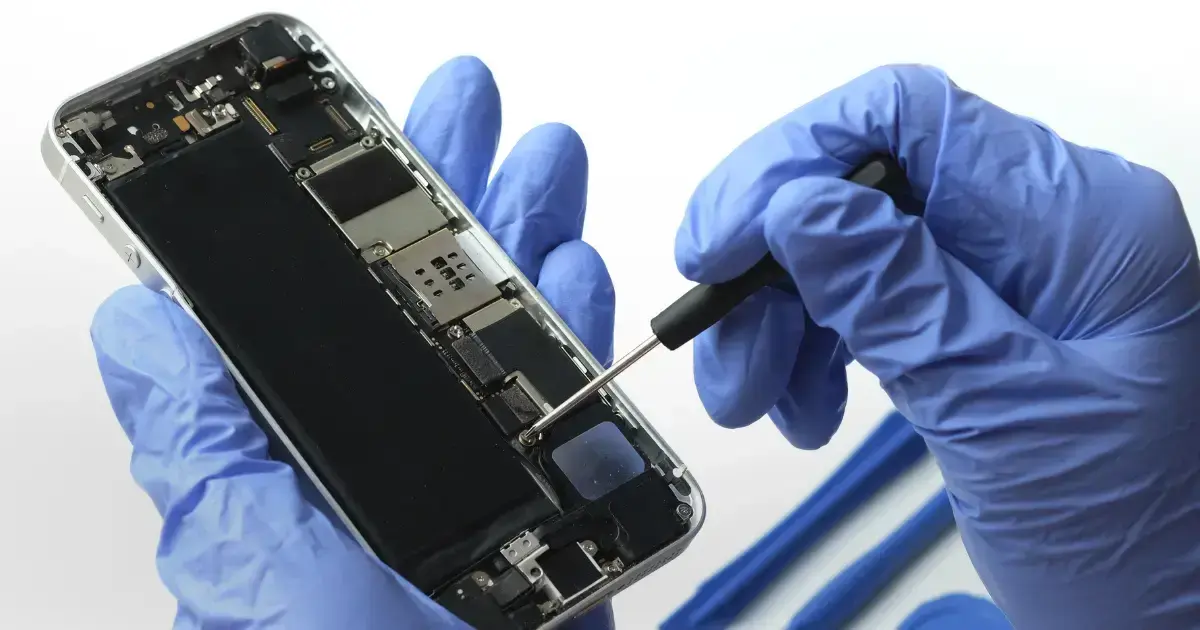From staying connected to managing busy schedules, smart devices are indispensable, keeping the market for mobile phone repairs strong in 2025.
In fact, 97% of Americans own a cell phone (85% of those being smartphones) — that’s a huge number of devices that will, at some point, need fixing.
And while that's good news for repair shops, it also means there's a lot of competition. So, how do you make your business stand out?
This blog explores five important mobile phone repairs in 2025, driven by trends like foldable phones, connectivity repairs, and artificial intelligence (AI) diagnostics, so you can set your business up for long-term success.
Let’s get started.
1. Advanced Displays & Structural Repairs
Foldable smartphones, once a niche product, are rapidly gaining popularity. Manufacturers like Samsung, OPPO, and Huawei offer devices with flexible displays and intricate folding mechanisms, but breaking them creates a whole new set of repair challenges.
These flexible OLED screens can experience crease damage or delamination, and repairing the complex hinge mechanisms requires precisely handling intricate parts and ensuring proper alignment.
But it’s not just foldables — even traditional smartphones are becoming more sophisticated. Repair shops must continue providing high-quality screen replacements while catering to more complex repairs like camera module and display calibration, even color correction to address software-based display issues. Housing and frame repairs are also becoming more complicated as new phone designs incorporate different materials and construction methods.
Tips for Advanced Mobile Phone Repairs
Here’s what you need to do to handle these increasingly complicated mobile phone repairs:
- Get specialized tools and equipment: Invest in the precise equipment needed to work on flexible displays and calibrate cameras.
- Provide in-depth tech training: Offer in-depth training focused on foldable phone construction and repair.
- Find reliable suppliers: Secure a high-quality supply of replacement screens, hinges, and housing components.
- Develop detailed repair procedures: Create step-by-step instructions to ensure consistent quality and minimize the risk of damage.
- Track parts and warranties: Use your point of sale (POS) software to manage inventory of specialized parts and track warranty claims for these complex repairs.
- Control your repair area: Keep dust and static away from sensitive parts to prevent damage.
By strengthening your and your team's knowledge in advanced display and structural repairs, you can better help customers with modern, sophisticated devices.
Related Read: What Is the Best Repair Tracking Software? 4 Top Solutions
2. Power & Connectivity Solutions
Whether for work, chatting with loved ones, or browsing social media, customers expect their phones to be on and operating normally 24/7 — making connectivity issues particularly disruptive. As a result, repair shops should offer services for both power-related and connectivity-related problems.
While battery replacements will always be a core repair service due to battery degradation, mobile phone repairs are shifting towards:
- Advanced power management: Technicians should be able to diagnose and address issues within the phone's power management integrated circuits (PMICs), often requiring microsoldering and specialized diagnostic tools.
- 5G and mmWave connectivity: The increasing prevalence of 5G, especially mmWave 5G, means repair shops should be able to fix the specialized antennas, RF front-end modules, and modems that support these advanced networks.
- Network & carrier aggregation: Modern phones use carrier aggregation to combine multiple frequencies for faster data speeds, and faults in the components managing this process are a growing concern.
- Wireless charging systems: While wireless charging is convenient, its complex circuitry can fail. Technicians need to properly diagnose issues with charging coils, power transmitters, and related components.
Tips for Power & Connectivity Repairs
To offer complex power and network system solutions at your repair shop, consider the following:
- Invest in RF diagnostic equipment: Acquire tools like spectrum analyzers, network analyzers, and RF power meters to diagnose 5G and other wireless connectivity issues.
- Provide advanced microsoldering training: Teach your technicians how to do delicate soldering work on small parts, especially ones that control power and radio signals.
- Maintain customer device records: Store information about customer devices and past repairs in your POS to help you diagnose recurring power or connectivity issues.
- Develop software troubleshooting skills: Train your techs to use software and error codes to diagnose power and connection issues.
- Create detailed repair documentation: Write detailed instructions for repairs and schematics for various power and network system failures.
Related Read: Essential Tools for Fixing Electronics: 8 Key Tools for Repair Shops
With a deeper focus on these advanced power and network system repairs, your shop can better position itself to handle all the intricacies of modern smartphones.
3. AI-Driven Diagnostics & Component Replacement
AI is changing how nearly every industry operates, and mobile phone repairs are no exception.
While traditional troubleshooting has relied on technician experience and manual testing, AI-driven tools can diagnose problems and even help the actual repair process.
For example, AI-powered software can analyze circuit board schematics and device layouts, helping techs quickly locate specific components, which can save time when fixing densely packed boards in modern smartphones.
AI-enhanced diagnostics are also becoming more common, with the ability to guide technicians through complex diagnostic procedures with step-by-step instructions. These smart tools can interpret test results, too, leading to faster and more accurate troubleshooting.
Tips for AI-Driven Diagnostics & Repairs
Here’s how you can set your shop up to fully utilize AI-assisted repairs:
- Invest in AI-powered diagnostic software: Get AI-driven tools to analyze device data, predict failures, and identify the right components.
- Train technicians on AI workflows: Teach your techs how to properly use AI software and interpret diagnostic information.
- Protect AI systems: Implement strict security measures to keep both customer data and your software from being hacked or tampered with.
- Stay updated on AI repair tech: Learn about the latest AI tools and techniques through industry publications, training, and conferences.
AI-driven diagnostics and component replacement give repair shops the tools necessary for faster, more accurate services — so you can always stay one step ahead of the competition.
4. Software & Data-Related Repairs
Smartphones act as handheld computers, making any software or data issues as debilitating as hardware failures. Consequently, mobile phone repair shops should expand their offerings to meet the demand for these software and data-related services.
For software troubleshooting, technicians need to be able to diagnose a wide range of issues, including:
- Operating system errors that cause instability or crashes
- App conflicts that lead to performance problems or security vulnerabilities
- Performance slowdowns stemming from memory management or background processes
- Security vulnerabilities that expose user data to risk
Related Read: 3 Must-Have Repair Management Software Features [+ 3 Top Providers]
Software optimization, which can improve device speed and battery life, is another growing area of demand. Users expect their phones to run smoothly and efficiently, and repair shops that can help them achieve this will gain a competitive edge.
Tips for Software & Data-Related Repairs
To effectively provide software and data-related repair services, use these strategies:
- Obtain specialized tools: Get the software and hardware tools required for various levels of data recovery, from simple file retrieval to more involved procedures.
- Provide ongoing training: Offer continuous training to keep technicians updated on software repair and data recovery methods.
- Control data access within your POS: Set user permissions in your POS system to restrict access to sensitive customer data during data recovery processes.
- Offer multiple data recovery options: Provide customers with data recovery options that fit various needs and budgets.
- Keep an eye on software updates: Make sure your techs know about the latest Android and iOS updates, plus how to install them.
Offering a full suite of software and data-related repair services lets your shop cater to a wider range of customer issues, from physical damage to complex software problems, increasing both your business’ traffic and customer satisfaction.
5. Wearable Device Integration & Repair
Smartwatches, fitness trackers, and other wearables are increasingly popular and typically linked to a smartphone. When something goes wrong with either device, it's a hassle — which is why mobile phone repair shops are seeing a growing demand to repair not only smartphones, but also their connected wearables.
This trend requires expertise in two main areas. First, repair shops need to be able to fix wearable device integration issues, including:
- Troubleshooting connectivity problems between phones and wearables, such as Bluetooth pairing failures or data syncing errors
- Diagnosing software and compatibility issues that affect the connectivity of both devices
- Providing guidance and support for setting up and configuring wearable device features
Second, there's a need for wearable device repair itself, which involves:
- Replacing batteries and screens on wearables, as these components are subject to wear and tear or accidental damage
- Repairing or replacing sensors and other internal components, such as heart rate monitors or GPS modules
- Addressing common wearable device problems like water damage or strap and band failures
Repairing wearables requires knowledge in both software-related issues (integration) and hardware-related problems (device repair), encouraging repair shops to broaden their technical capabilities.
Tips for Wearable Device Repairs
If you want your store to offer wearable device integration and repair services, consider the following:
- Provide specialized training for technicians: Teach your staff how to fix specific brands and models of smartwatches and fitness trackers.
- Stock wearable replacement parts: Keep common parts like batteries, straps, and screens on hand so you can do repairs quickly.
- Bundle wearable repairs with phone services in your POS: Create service packages and pricing options for customers needing both phone and wearable device repairs, managed directly within your POS.
Offering wearable device repairs is a great way for your business to meet customer demands and become known as the spot that handles everything mobile.
Related Read: Top Cell Phone Store POS Software Solutions for 2025
How To Tackle Complex Mobile Phone Repairs in 2025
While basic mobile phone repairs will always remain part of the business, expertise in foldable devices, advanced power and network systems, and AI-driven diagnostics will be some of the main drivers for success in 2025.
Both repair shop owners and technicians need to know how to handle flexible displays and complex hinges, understand RF and microsoldering techniques, and effectively utilize AI for efficient fixes.
To manage these complexities, consider a POS system (like CellSmart POS) designed to handle the demands of modern-day mobile phone repairs, all while delivering exceptional customer service and simplifying your day-to-day.
Schedule a free demo of CellSmart POS today to see how it can help your business thrive.






